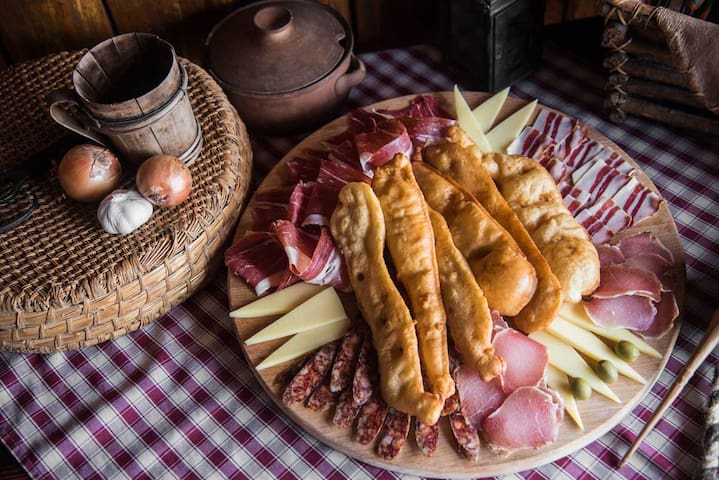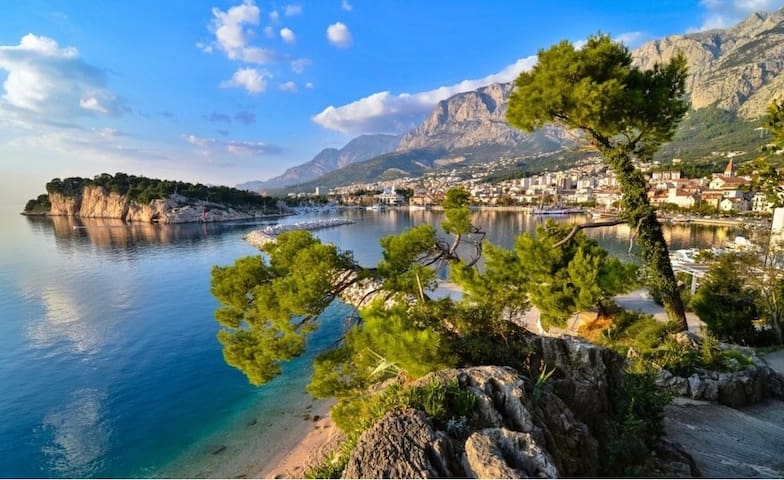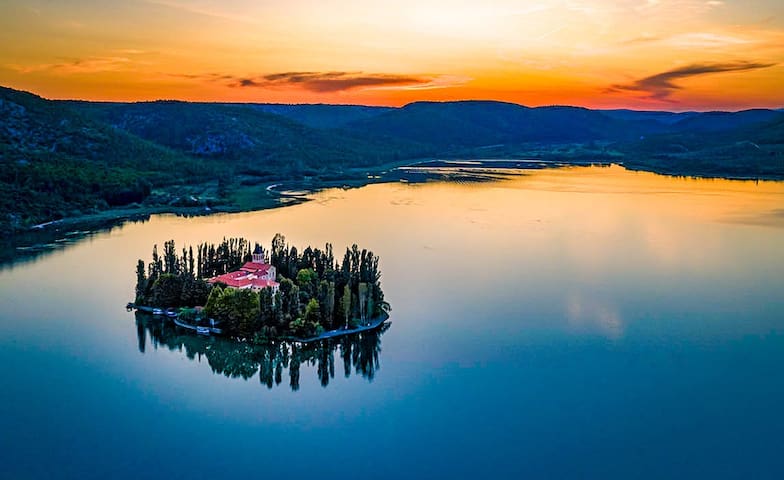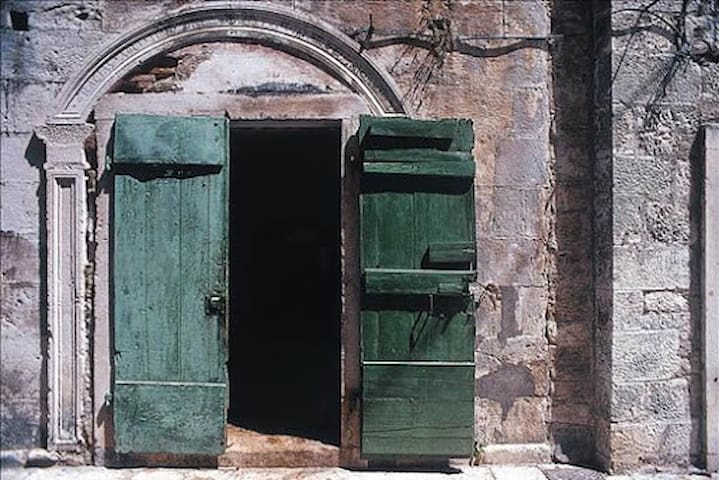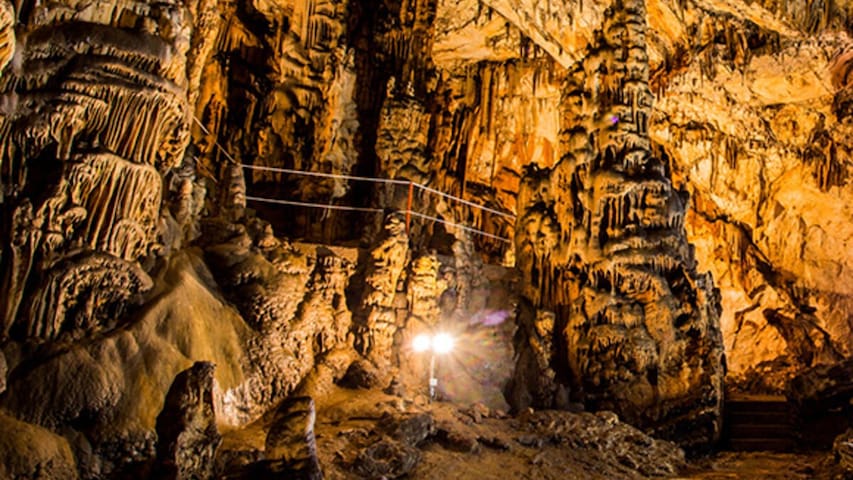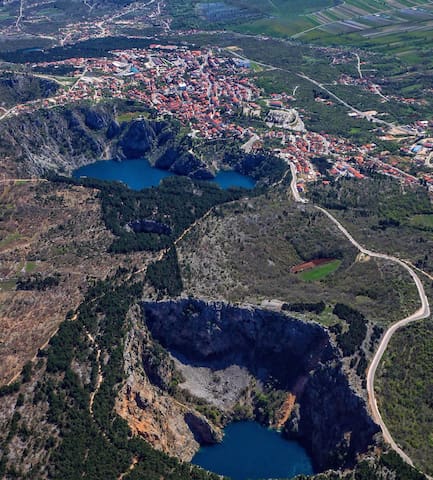Neighbouring places
Sinj
Omiš
Makarska
Stobreč
bb Put Svetog LovreTrogir
DRNIŠ
where to go
famous landmarks, historic sites and beauties of nature in Split surrounding
One of the most mysterious and beautiful sites in the Dalmatian hinterland behind Split, the incredible 10 Rajcica Wells - off the road between Klis and Drniš - are ripe for discovery by those wanting to escape into nature and they're the perfect place for picnics
Aside from an old stone wall that runs through the meadow, the 10 Rajcica Wells are the only telltale signs that this land has ever been touched by the hands of man. No buildings or telegraph poles are insight. No sounds interrupt the calm of the incredible scenery. If you're not alone at the 10 Rajcica Wells when you visit, it's because this is a popular place for those in-the-know to come for picnics. But, the 10 Rajcica Wells has the effect of calming all who come.
Bunari Rajčica - Final - Central Dalmatia Croatia - Theme Trails
One of the most mysterious and beautiful sites in the Dalmatian hinterland behind Split, the incredible 10 Rajcica Wells - off the road between Klis and Drniš - are ripe for discovery by those wanting to escape into nature and they're the perfect place for picnics
Aside from an old stone wall that runs through the meadow, the 10 Rajcica Wells are the only telltale signs that this land has ever been touched by the hands of man. No buildings or telegraph poles are insight. No sounds interrupt the calm of the incredible scenery. If you're not alone at the 10 Rajcica Wells when you visit, it's because this is a popular place for those in-the-know to come for picnics. But, the 10 Rajcica Wells has the effect of calming all who come.
The road from Klis to Drniš can sometimes feel like a step back in time. The 20-minute drive from the bustle of coastal city Split up to Klis is one that more and more visitors are wisely choosing to take. Perched in the high foothills of the Dinaric Alps, Klis's spectacular fortress, featured in Game of Thrones, is a captivating visit. The views it offers of the seaside city below will leave you breathless.
The Fortress of Klis (Tvrđava Klis) has a history of more than 2000 years, beginning with the Illyrian tribe called Dalmatae that used it as a stronghold before it was taken by the Romans. After the fall of the Roman Empire, the site became a seat for several Croatian kings.
Later, the Klis Fortress was pivotal in defending the Balkans against the siege of the Mongols, then the Ottomans in the 1500s.
329 lokal ang nagrerekomenda
Kuta ng Klis
10 Trg MejdanThe road from Klis to Drniš can sometimes feel like a step back in time. The 20-minute drive from the bustle of coastal city Split up to Klis is one that more and more visitors are wisely choosing to take. Perched in the high foothills of the Dinaric Alps, Klis's spectacular fortress, featured in Game of Thrones, is a captivating visit. The views it offers of the seaside city below will leave you breathless.
The Fortress of Klis (Tvrđava Klis) has a history of more than 2000 years, beginning with the Illyrian tribe called Dalmatae that used it as a stronghold before it was taken by the Romans. After the fall of the Roman Empire, the site became a seat for several Croatian kings.
Later, the Klis Fortress was pivotal in defending the Balkans against the siege of the Mongols, then the Ottomans in the 1500s.
The Cetina River Spring (Izvor Cetine), also known as the Eye Of The Earth is an incredible karst spring located at the foothills of the Dinara mountain range in Croatia. The Eye Of The Earth in Croatia got its name, because it looks like a blue-green dragon eye from above.
25 lokal ang nagrerekomenda
Bukal ng Ilog Cetina
The Cetina River Spring (Izvor Cetine), also known as the Eye Of The Earth is an incredible karst spring located at the foothills of the Dinara mountain range in Croatia. The Eye Of The Earth in Croatia got its name, because it looks like a blue-green dragon eye from above.
Walking through the numerous narrow alleyways of the old town, almost at every corner you’ll discover a quaint little square or a charming house. One of them is especially cherished by the locals and interesting to tourists. After all, there aren’t many houses in the world with an official name, and let alone a name as peculiar as this one - "The House of a Happy Man".
This beautiful Renaissance house got its name by a Latin inscription above the entrance that reads, in translation: "I thank thee, Lord, for having lived in this world" (GRATIAS AGO TIBI DNE QUIA FUI IN HOC MONDO). It is believed that it used to be the house of Ivan Primojević, a lawyer and the ambassador of Omiš commune in Venice.
Unfortunately, not much is known today about its original owner, but the house itself has luckily been well preserved over the centuries and today represents one of the most beautiful examples of classic Dalmatian architecture of the Venetian period.
"The House of a Happy Man" was originally built with the workshops and living room on the ground floor, sleeping quarters on the first floor and the kitchen on the top floor. Such an organization of the interior had baffled historians for a long time, until they finally figured out why medieval architects designed the interior in such a, seemingly, inpractical way.
The reason lay in the fact that many houses of the period suffered destruction by fire, and sources of fire are at home most commonly found in the kitchen. As houses with kitchens on lower floors were mostly turned into ashes in fires, the medieval inhabitants of Omiš realized with time that lifting the kitchen up to higher floors would significantly reduce the possible damage caused by fires, which soon made this particular form of interior design a standard in Omiš.
"The House of a Happy Man " was one of the first ones in town to have been built in this – at the time still innovative – manner. Who knows, this may well be the reason why its owner‘s happiness ;)
House Of happy man
1 Domovinskog rataWalking through the numerous narrow alleyways of the old town, almost at every corner you’ll discover a quaint little square or a charming house. One of them is especially cherished by the locals and interesting to tourists. After all, there aren’t many houses in the world with an official name, and let alone a name as peculiar as this one - "The House of a Happy Man".
This beautiful Renaissance house got its name by a Latin inscription above the entrance that reads, in translation: "I thank thee, Lord, for having lived in this world" (GRATIAS AGO TIBI DNE QUIA FUI IN HOC MONDO). It is believed that it used to be the house of Ivan Primojević, a lawyer and the ambassador of Omiš commune in Venice.
Unfortunately, not much is known today about its original owner, but the house itself has luckily been well preserved over the centuries and today represents one of the most beautiful examples of classic Dalmatian architecture of the Venetian period.
"The House of a Happy Man" was originally built with the workshops and living room on the ground floor, sleeping quarters on the first floor and the kitchen on the top floor. Such an organization of the interior had baffled historians for a long time, until they finally figured out why medieval architects designed the interior in such a, seemingly, inpractical way.
The reason lay in the fact that many houses of the period suffered destruction by fire, and sources of fire are at home most commonly found in the kitchen. As houses with kitchens on lower floors were mostly turned into ashes in fires, the medieval inhabitants of Omiš realized with time that lifting the kitchen up to higher floors would significantly reduce the possible damage caused by fires, which soon made this particular form of interior design a standard in Omiš.
"The House of a Happy Man " was one of the first ones in town to have been built in this – at the time still innovative – manner. Who knows, this may well be the reason why its owner‘s happiness ;)
Mirabella fortress - one of the most popular landmarks of Omiš. Just above the roofs of the old town, as a permanent reminder of the glorious pirate history, stands one of the most famous Omiš landmarks – the fortress of Mirabela. The old pirates of Omiš used Mirabela as a lookout over the Channel of Brač, so that rich merchant ships had no way of sailing along the coast of Omiš unnoticed. The fortress itself was built in the 13th century, and, interestingly enough, its age was in fact determined based on an old Byzantine coin that some visionary pirate had obviously thrown into its foundations, making it much easier for future generations to determine the age of this important fortress and a long-standing witness of numerous wars and battles throughout the history in which it undoubtedly played a crucial role.
84 lokal ang nagrerekomenda
Tvrđava Mirabela
1 PeovoMirabella fortress - one of the most popular landmarks of Omiš. Just above the roofs of the old town, as a permanent reminder of the glorious pirate history, stands one of the most famous Omiš landmarks – the fortress of Mirabela. The old pirates of Omiš used Mirabela as a lookout over the Channel of Brač, so that rich merchant ships had no way of sailing along the coast of Omiš unnoticed. The fortress itself was built in the 13th century, and, interestingly enough, its age was in fact determined based on an old Byzantine coin that some visionary pirate had obviously thrown into its foundations, making it much easier for future generations to determine the age of this important fortress and a long-standing witness of numerous wars and battles throughout the history in which it undoubtedly played a crucial role.
Skywalk Biokovo is a horseshoe-shaped platform out off the cliff with a glass walkway. It is located in the southwestern part of the Biokovo Nature Park on the 13th km of the Biokovo road and next to the info-center, at an altitude of 1228 meters above the sea level where specific weather conditions prevail. In front of info-center is a geological pillar - a three-dimensional view of the cross-section of the rocks that formed the area of Biokovo from its inception to the present day with a geological time table and description of the age and types of rocks
132 lokal ang nagrerekomenda
Biokovo Skywalk
2/A Biokovska cestaSkywalk Biokovo is a horseshoe-shaped platform out off the cliff with a glass walkway. It is located in the southwestern part of the Biokovo Nature Park on the 13th km of the Biokovo road and next to the info-center, at an altitude of 1228 meters above the sea level where specific weather conditions prevail. In front of info-center is a geological pillar - a three-dimensional view of the cross-section of the rocks that formed the area of Biokovo from its inception to the present day with a geological time table and description of the age and types of rocks
Fortica fortress - If you are spending more than a day in Omiš, a short climb up to the Fortica fortress is something you should by no means miss. A well-marked path leading from the very centre of town will take even the ones not exactly in top form up to the fortress in less than an hour, and once there, you’ll be richly rewarded for your efforts by one of the most magnificent views in all of Dalmatia. Once you set foot onto the more than 500 years old fortress, you’ll understand in an instance why the medieval inhabitants of Omiš hauled the heavy stone blocks all the way up to the top of the mountain in the first place. The one of a kind view over the islands of Brač, Hvar and Šolta, the Cetina canyon and a good portion of Poljica offered from the top of the fortress will prove itself as reason enough for such labour. Fortica was, in fact, primarily used as a lookout, and whatever the direction the enemies approached from, the watch guards would be able to spot them early enough to warn the inhabitants of Omiš of danger. This is why precisely the Fortica fortress is said to be one of the most important reasons for the town of Omiš remaining unconquered throughout its entire history.
35 lokal ang nagrerekomenda
Starigrad Fortress
Put BaučićaFortica fortress - If you are spending more than a day in Omiš, a short climb up to the Fortica fortress is something you should by no means miss. A well-marked path leading from the very centre of town will take even the ones not exactly in top form up to the fortress in less than an hour, and once there, you’ll be richly rewarded for your efforts by one of the most magnificent views in all of Dalmatia. Once you set foot onto the more than 500 years old fortress, you’ll understand in an instance why the medieval inhabitants of Omiš hauled the heavy stone blocks all the way up to the top of the mountain in the first place. The one of a kind view over the islands of Brač, Hvar and Šolta, the Cetina canyon and a good portion of Poljica offered from the top of the fortress will prove itself as reason enough for such labour. Fortica was, in fact, primarily used as a lookout, and whatever the direction the enemies approached from, the watch guards would be able to spot them early enough to warn the inhabitants of Omiš of danger. This is why precisely the Fortica fortress is said to be one of the most important reasons for the town of Omiš remaining unconquered throughout its entire history.
The Vranjača Cave is situated in the heart of the Dalmatian hinterland, in the village of Kotlenice, a half hour drive away from Split and only 10 minutes drive away from Dugopolje. The cave is located at the foot of the central part of Mount Mosor, on its north-facing slopes, and consists of two parts.
The entrance, with no decoration, has been known to the locals since ancient times, whereas the other part was discovered in 1903 by the owner of a piece of land where the cave is located, Mr Stipe Punda. The Vranjača cave was opened to the public in 1929. A small natural passage leads from the entrance chamber to a chamber composed of 9 smaller parts full of cave decorations in all shapes, sizes and colours.
A specific feature of the cave is that its interior maintains a constant year-round temperature of about 15⁰C. Full of stalactites and stalagmites, pillars and arcades, Vranjača is one of the most beautiful pearls of the karst landscape, declared a protected geomorphological natural monument in 1963.
Not far away from the cave entrance is the starting point for hiking trails that lead to the peak called Vickov stup (1,325 m). The Punda family from Kotlenice manage the organisation of visits to the Vranjača cave and are responsible for all maintenance.
48 lokal ang nagrerekomenda
Kweba ng Vranjaca
The Vranjača Cave is situated in the heart of the Dalmatian hinterland, in the village of Kotlenice, a half hour drive away from Split and only 10 minutes drive away from Dugopolje. The cave is located at the foot of the central part of Mount Mosor, on its north-facing slopes, and consists of two parts.
The entrance, with no decoration, has been known to the locals since ancient times, whereas the other part was discovered in 1903 by the owner of a piece of land where the cave is located, Mr Stipe Punda. The Vranjača cave was opened to the public in 1929. A small natural passage leads from the entrance chamber to a chamber composed of 9 smaller parts full of cave decorations in all shapes, sizes and colours.
A specific feature of the cave is that its interior maintains a constant year-round temperature of about 15⁰C. Full of stalactites and stalagmites, pillars and arcades, Vranjača is one of the most beautiful pearls of the karst landscape, declared a protected geomorphological natural monument in 1963.
Not far away from the cave entrance is the starting point for hiking trails that lead to the peak called Vickov stup (1,325 m). The Punda family from Kotlenice manage the organisation of visits to the Vranjača cave and are responsible for all maintenance.
In dawn of its 300th anniversary, the pride of Croatian tradition and long-lasting cultural historical heritage has finally been given a home in which it can display itself in its full glory. In the heart of Alka halls, in place of the old Venetian republic's Kvartiri – which were the barracks for the Croatian cavalry – now sits a magnificent collection of the Museum of the Sinjska Alka. Between the Petrovac fountain in the south and the Duke's quarters in the north lies a building complex that satisfies even the highest of museum standards. It comprehensively ties the past and the present, and in its priceless value keeps the Alka identity, securing the future for generations to come.
Each visitor will be able to experience the greatness of Alka all year round, culminating in August: from the lavishly decorated original alkars' and alkar's squiers' uniforms, valuable equipment and weaponry, 300-year-old historical objects, to a special attraction – a life-sized display of the Alka procession.
Since the connection between the historical and the contemporary is always present in Sinj in a unique way, one can experience the famous Battle of 1715 in a multimedia environment, as well as browse old Alka statues and ruel books. It is also possible to view a documentary film within the permanent collection, dealing with the history of Alka, which gives a new dimension to the experience of the knightly competitions such as oko sokolovo and čvrsta desnica.
Museum of the Sinjska Alka is a place where everybody – including natives and tourists, young and old – will find something interesting and surely be inspired by a uniques gem of Croatian and global intangible cultural heritage, the value of which is even protected by UNESCO.
A cultural, scientific and a pedagogical-educative institution are united in a unique, professionally designed space, representing, keeping and protecting rich archives.
30 lokal ang nagrerekomenda
Museo Alka ng Sinj
12 Put PetrovcaIn dawn of its 300th anniversary, the pride of Croatian tradition and long-lasting cultural historical heritage has finally been given a home in which it can display itself in its full glory. In the heart of Alka halls, in place of the old Venetian republic's Kvartiri – which were the barracks for the Croatian cavalry – now sits a magnificent collection of the Museum of the Sinjska Alka. Between the Petrovac fountain in the south and the Duke's quarters in the north lies a building complex that satisfies even the highest of museum standards. It comprehensively ties the past and the present, and in its priceless value keeps the Alka identity, securing the future for generations to come.
Each visitor will be able to experience the greatness of Alka all year round, culminating in August: from the lavishly decorated original alkars' and alkar's squiers' uniforms, valuable equipment and weaponry, 300-year-old historical objects, to a special attraction – a life-sized display of the Alka procession.
Since the connection between the historical and the contemporary is always present in Sinj in a unique way, one can experience the famous Battle of 1715 in a multimedia environment, as well as browse old Alka statues and ruel books. It is also possible to view a documentary film within the permanent collection, dealing with the history of Alka, which gives a new dimension to the experience of the knightly competitions such as oko sokolovo and čvrsta desnica.
Museum of the Sinjska Alka is a place where everybody – including natives and tourists, young and old – will find something interesting and surely be inspired by a uniques gem of Croatian and global intangible cultural heritage, the value of which is even protected by UNESCO.
A cultural, scientific and a pedagogical-educative institution are united in a unique, professionally designed space, representing, keeping and protecting rich archives.
Hotel Salona Palace
Visit Split Online Guide
More from Croatia Traveller
Car Rental Croatia: Cross-Border Card Necessary? - Croatia Travel Blog
Car Rental Croatia: Cross-Border Card Necessary? - Croatia Travel Blog
croatiatraveller.com
Swimming in Plitvice Lakes: An Alternative - Croatia Travel Blog
Swimming in Plitvice Lakes: An Alternative - Croatia Travel Blog
croatiatraveller.com
Top Ten Travel Mistakes in Croatia - Croatia Travel Blog
Top Ten Travel Mistakes in Croatia - Croatia Travel Blog
croatiatraveller.com
Sea Fishing in Croatia: Regulations, licenses, prices
Sea Fishing in Croatia: Regulations, licenses, prices
www.croatiatraveller.com
Sipan Island
Sipan Island
www.croatiatraveller.com
Zagreb Trams
Zagreb Trams
www.croatiatraveller.com
National Parks and Heritage Sites Itinerary
National Parks and Heritage Sites Itinerary
www.croatiatraveller.com
Mljet Island Travel Guide
Mljet Island Travel Guide
www.croatiatraveller.com
AddThis
Visit Trogir
The remarkable Roman ruins of Salona are just outside Solin, a sleepy suburb just 5km northeast of Split . Now part of an archaeological park, the Salona ruins are extensive, testifying to the importance of this colony under Roman rule. As they are relatively unvisited, wandering this empire of ruins is an evocative journey to an era of emperors, gladiators and Christian martyrs.
Archeological site Salone
17 Paraći ul.
Hotel Salona Palace
Visit Split Online Guide
More from Croatia Traveller
Car Rental Croatia: Cross-Border Card Necessary? - Croatia Travel Blog
Car Rental Croatia: Cross-Border Card Necessary? - Croatia Travel Blog
croatiatraveller.com
Swimming in Plitvice Lakes: An Alternative - Croatia Travel Blog
Swimming in Plitvice Lakes: An Alternative - Croatia Travel Blog
croatiatraveller.com
Top Ten Travel Mistakes in Croatia - Croatia Travel Blog
Top Ten Travel Mistakes in Croatia - Croatia Travel Blog
croatiatraveller.com
Sea Fishing in Croatia: Regulations, licenses, prices
Sea Fishing in Croatia: Regulations, licenses, prices
www.croatiatraveller.com
Sipan Island
Sipan Island
www.croatiatraveller.com
Zagreb Trams
Zagreb Trams
www.croatiatraveller.com
National Parks and Heritage Sites Itinerary
National Parks and Heritage Sites Itinerary
www.croatiatraveller.com
Mljet Island Travel Guide
Mljet Island Travel Guide
www.croatiatraveller.com
AddThis
Visit Trogir
The remarkable Roman ruins of Salona are just outside Solin, a sleepy suburb just 5km northeast of Split . Now part of an archaeological park, the Salona ruins are extensive, testifying to the importance of this colony under Roman rule. As they are relatively unvisited, wandering this empire of ruins is an evocative journey to an era of emperors, gladiators and Christian martyrs.
Nature was at play in Imotski unlike anywhere else in the world. This town in the Dalmatian Hinterland, shielded by the protective embrace of Biokovo Mountain, contains two natural phenomena – Red and Blue Lakes, which have been the subject of numerous stories and legends over the years.
You can reach the Blue Lake (Modro jezero) beneath Topana Fortress on foot if you are in good shape, and there are at least three good reasons to do so. The first one is to take a swim in the lake, one that exhibits “50 shades of blue”, with a view of the surrounding cliffs, which you will remember for the rest of your life. The second one is the sight of fairies that soak in the beauty of the lake at dawn and at sunset – according to local legend, humans have never stepped foot in the nearby Fairy Cave (Vilinska pećina).
14 lokal ang nagrerekomenda
Imotski - Modro i Crveno Jezero - Central Dalmatia Croatia - Bike Tracks
Jezeranska ulica
Nature was at play in Imotski unlike anywhere else in the world. This town in the Dalmatian Hinterland, shielded by the protective embrace of Biokovo Mountain, contains two natural phenomena – Red and Blue Lakes, which have been the subject of numerous stories and legends over the years.
You can reach the Blue Lake (Modro jezero) beneath Topana Fortress on foot if you are in good shape, and there are at least three good reasons to do so. The first one is to take a swim in the lake, one that exhibits “50 shades of blue”, with a view of the surrounding cliffs, which you will remember for the rest of your life. The second one is the sight of fairies that soak in the beauty of the lake at dawn and at sunset – according to local legend, humans have never stepped foot in the nearby Fairy Cave (Vilinska pećina).

